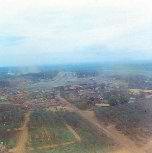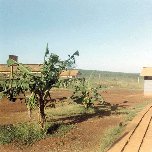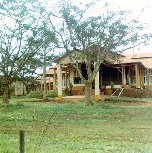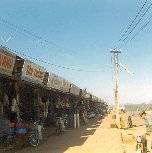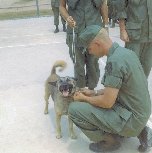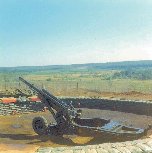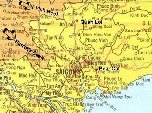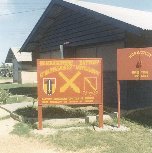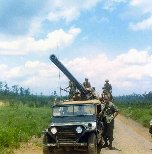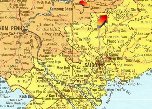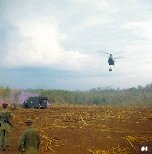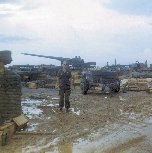|
Click Image to Link |

By December of 1969, things had quieted down considerably in South Vietnam
after the ugly spring and summer hostilities. In spite of the intensity during
the first half of 1969, even that was an improvement over the NVA-VC Tet
Offensive in early 1968.
As the New Year dawned in 1970, political pressure was intense to bring some
American troops home. I knew from my time with BG LD Kinnard, II Field Force
Vietnam Artillery
Commanding General in Long Binh, that contingency plans were well underway. Because their home
base was in Hawaii, popular money was on the 25th Infantry Division to go home
first. But since Hawaii would be a stepping-stone in the Pacific for units
headed back to CONUS (Continental United States), logic convinced some of us
that they would be last. Popular money lost. The 25th wasn’t the last, but
damned near.
Quan Loi was originally a village drawing life from a French rubber plantation
in the highlands of northern III Corps near An Loc. To characterize Quan Loi by
its red soil is right on the money. Everyone back in the U.S. who knew someone
doing military service in Quan Loi saw letters from there right away in a stack
of mail. Envelopes would be smudged dirty rouge from the red clay, painted into
the paper by sweaty hands that were sticky with perspiration almost constantly.
The soil must have been good for rubber trees since the plantation was the
reason for Quan Loi’s existence. Quan Loi was a part of the Terra Rouge Rubber
Company. Michelin plantation was some miles to the south. We referred to the
land, trees and buildings at Quan Loi simply as “Frenchie’s”.
Colonial Vietnam must have been idyllic. The climate, although tropical, (ever
see the sun “really” directly overhead?) allowed for lush vegetation, a vibrant
economy, and beauty all it’s own on this earth.
Frenchie had a terrific house,
architecturally matching out-buildings, a swimming pool out of the movies and
plenty of domestic help. Now it sat idle, abandoned, occasionally searched by US
troops for VC and troublemakers. I invited myself on one of those outings; rifle
in hand, just to see what it was like over there.
The rubber plantation provided cover for sappers and night invasions and rocket
attacks were popular right around reveille or dinner. The perimeter at Quan Loi
was probed many times, most severely in early
1969 before I got there. Haymaker
George, a dog, (Haymaker was the battalion call sign), woke up many of
Headquarters and “A” Battery soldiers on that occasion, and the enemy was gunned
down right in the middle of the compound. Haymaker George subsequently moved to
Phu Loi with us when I moved HHB there in March, 1970, and we awarded him a
Bronze Star. I hope he lived out his life in comfort.
The 11th Armored Cavalry Regiment
provided perimeter defense at Quan Loi. When I got in country in the middle of
1969, Col. George S. Patton III commanded the 11th ACR. Just like his father
before him, Col. Patton brought a commitment to mission that didn't necessarily
follow the book. Col. Don Starry took over the 11th ACR by January of 1970 and
continued to foster the distinct prowess of the Armored Cav. The
11th ACR
did some real ass-kicking in battle! Personally, I still prefer the
role the
artillery played. But with the Armored Cav. on the perimeter
of Quan Loi, it was another part of the Vietnam experience with its own distinct
memories.
A detached unit of
twin-40 BoFors (Dusters) worked perimeter defense.
Technically a twin-40 is Air Defense Artillery, but they were nicknamed
“Pom-Pom”s because of the slow rhythmic “pom-pom-pom” sound from the alternating
twin barrels firing. Trained at ground level instead of at fixed-wing aircraft
as intended during WWII and Korea, they could smash rubber trees better than
anything else in the arsenal. The round was an explosive 40 mm warhead. A
popular story used to be that the US paid Frenchie $500 for every tree that got
destroyed. I figured by the end of the war, we would have mowed all the rubber
trees back to Cambodia and Frenchie could resume the life to which he’d become
accustomed.
I’ve digressed here, so back to the New Year. Since redeployment of much of the
US Forces was in the planning stages by early 1970,
President Nixon needed to
show the world who was boss, before we crept away to lick our wounds. An
invasion into the Cambodian sanctuaries was decided upon by DOD and it made good
sense. The NVA and Charlie would put large caches of weapons and food in
Cambodia just across the border from Vietnam because it was safe there. Being
the gentlemen that Americans are, no one went into Cambodia on foot, much less
fired weapons over there. We Americans, even in war, are above reproach, unless
it was by accident. But truth be known, there were secret initiatives that took
unmarked military equipment and Americans without ID into Cambodia to cause
trouble and do surveillance. And occasionally, even we artillerymen would lose
our heads and forget that the target coordinates were across the border.
As the contraction in ground forces commenced, Quan Loi, being just shy of the
Cambodian border in Vietnam’s northern III Corps, was destined to become
obsolete rather quickly. It existed only from American military might and
largesse, torn out of the red dirt, paved into an
airstrip by whatever asphalt
could be got and PSP (perforated steel plate). Why there? I think Frenchie
actually had a dirt strip at one time to ferry in people and the good life to
his plantation. In March, I became HHB CO, loaded up all the gear in our PLL,
and headed south to Phu Loi. Unbeknownst to most of us, the Cambodian invasion
was set for April along with other strategic changes in Quan Loi.
As the Cambodian battle plan rolled out in early April, I left the still
unfinished HHB installation in Phu Loi to take part of
“A” Battery out of Quan
Loi. “A” Battery, as a heavy artillery battery is configured, had two 175 mm
guns and two 8-inch howitzers. Gun or howitzer, the guns were guns and we were
“gun bunnies”.
There is a distinction between a gun and a howitzer - Technically, a gun fires a
projectile on a low, flat trajectory at a high muzzle velocity, while a howitzer
fires a projectile on a slower and higher trajectory.
According to pictures I have to this day, I took the two 175 mm guns on my
mission. Memory doesn’t always serve me well. We went to an area west of
Tay
Ninh City, known for being in the shadow of Nui Ba Den (the Black Virgin
Mountain), another VC sanctuary, and as best I can determine from maps, to an
area around
Go Dau Ha, to support border crossings into Cambodia in the area
known as the “Angel’s Wing”, or perhaps further south at the border anomaly
known as Parrot’s Beak”. Look at a
map – that’s the shape.
The other half of "A" Battery, two 8 inch howitzers, had left Quan Loi shortly
after Christmas 1969 and after stops at several fire support bases headed for a
new location around Loc Ninh, the last settlement on Highway 13 before the
Cambodian border. I believe they were to establish a fire base and support
border crossings in the area known as the “Fishhook”. Again, look at a
map. By
the way, this area of northern III Corps was defoliated like hell, Loc Ninh,
Quan Loi, and over into Song Be and
Nui Ba Ra (the Little Black Virgin). We
drank local water, runoff, treated with Halazone. You have to know that
Agent
Orange was still in there. [VA
Site]
It wasn’t even until I sat to write this that I realized how we split "A" Battery
up. The 8 inch howitzers have a range of just over 16,800 meters (10 miles),
sufficient to hit Cambodia from Loc Ninh. And the 175 mm guns have a range of
over 32,000 meters (about 20 miles). We needed the extra range to get deep into
the “Angel's Wing” sanctuaries because it was more open. The “Fishhook” was a
narrow piece of ground nestled in the hook.
Away we convoyed from Quan Loi, the guns never to return. Diesels roaring,
tracks clanking, soldiers looking nervously left and right, we motored like hell
to get to our destination before dark. Dusty – you don’t know the meaning of the
word. Remember, no pavement in Viet Nam, at least, not in early 1970.
We probably bitched too much about the dust because by the time we got to our
destination near Go Dau Ha, the monsoons had opened up. I have pictures of us
standing in muck, the two guns with spades jammed into the ground for fire
missions, ammunition scattered among trenches that the engineers had carved out
of the ground for us to build bunkers in. And steel culverts, sitting there to
form the roofs of protective bunkers with sand bags for armor.
Rain, rain and
more rain.
The worst thing in the world is to go into night with ammunition unprotected. As
lethal as it is on the receiving end, it is just as lethal to us if a rocket or
mortar gets dropped into it. And now it was raining and we needed to get it
underground as night settled in. The ground was not unlike Quan Loi, a high
degree of clay, which made it as slick as owl shit when it was wet.
I jump off once again on technicalities. A 175 mm round weighs about 148 pounds.
It has a ring-bolt screwed into the nose where the fuse goes in before firing,
and a steel bar stuck through the ring is how two 13-Alphas lug a single round
from point A to point B. The steel canisters with the incremental powder bags
come in at around 70-80 pounds. Anyway, the rounds, at around 150 pounds, on owl
shit, in rain and growing darkness, trying to go down a sloped dirt hole, were a
nightmare. I damned near had a mutiny on my hands. I kept thinking it couldn’t
have been any better up near Loc Ninh where the
8-inch howitzers had gone. Those
projectiles weigh around 192 pounds, same ring-bolt carrying technique.
Anyway, after some “family meetings”, lots of cussing, and wondering how this
would all end up, we got some of the ammunition stowed and got tents and cots up
to sleep. Part of the ammo still in the 5-ton truck beds got sand bags thrown on
top as some measure of protection. In retrospect, by the book, I probably should
have been court-martialed for allowing that to happen.
The next day was a better day, more work got done to clean up the battery area,
and the war went into full gear. We fired many fire missions and watched and
took pleasure in seeing secondary explosions erupt from Cambodia from ammunition
and fuel caches ignited by ground and mechanized units, bombs, and artillery
shells.
Some days went by and Banks and I got called back to Phu Loi. There we were
briefed on the next phase of the mission. I was to reunite the two 175 mm guns
with their sister 8-inch howitzers in Loc Ninh, and again make the trip in a
single day. Never a dull moment. President Nixon had already cost me my R&R by
scheduling his Cambodian invasion in April, so what the hell. Banks and I drove
back only to find out that an element of the 11th ACR had swept the road after
we left and found a 40 pound mine unexploded under a drink can detonator. I
thanked Banks for not targeting cans as he drove the jeep down the road.
On the road again! Uneventful, except as we got near
Quan Loi there was trouble
on Highway 13 and military traffic was a mess. I detoured my convoy into the
rubber plantation, remembering other routes through it from earlier excursions.
Banks and I drove down the road in the lead jeep and there, dead ahead, I saw a
small bridge over a ditch. We bounced over the bridge in the jeep, and traveling
at about 20 MPH with the rest of the vehicles bearing down, my heart stopped and
I died several deaths in a split second. The bridge looked like Vietnamese
laborers had thrown it together from logs and mud. Apart from the number of
large vehicles in the convoy, each of the two guns weighed in at just over 30
tons alone! I had blinding visions of the bridge collapsing, and once again
being a little too smart for my own good. Shit!!!
But they made it! The only thing I can surmise is that the vehicles were so
large, by the time the front end of any vehicle crossed the other side of the
little bridge, the rear end still wasn’t on it. So the entire weight never came
to rest on the sad little bridge.
Mission accomplished – “A” Battery was once again together, only now in the
vicinity of Loc Ninh. We spent some time on Highway 13, reconn’d as far as Snuol
in the event the contingencies to take the battle well into Cambodia were to be
exercised, and enjoyed President Nixon’s marvelous adventure. It was still
unclear how far American forces would have to push into Cambodia to clear out
enemy caches.
But Cambodia was not to be. Enemy caches were relatively close to Vietnam on
the Cambodian side, and taking them out by bomb or artillery fire proceeded
rapidly with little resistance. So I returned to Phu Loi and HHB.
Such was the turning point in the Vietnam war. History shows us it was not to
progress along the lines that hopes and plans would have had it, but someone
else will have to tell the rest of the story of “A” Battery, never to return to
Quan Loi, but to wander the northern reaches of III Corps before finally
returning to Fort Lewis, Washington, in November of 1971, for inactivation.
The following poem was typed by someone during my tour in Vietnam, in an
orderly room somewhere between Quan Loi and Phu Loi. The actual piece of paper
survives, but my memory of who wrote it failed me many years ago. I have carried
it faithfully during all my moves. But I kept it because I was struck by its raw
message; the words absolutely poignant and correct in their clarity. And there
actually were lizards that sounded like ducks.
If the author ever reads this, stand up and take a bow. I write it exactly as
you typed it.
NUI BA RA, NUI BA DEN,
THE BLACK VIRGIN SLEEPS AGAIN,
THE LIZARD QUACKS LIKE A DUCK,
ALL IS QUIET NOBODY FUCKS;
NIGHT IS DARK EXCEPT FOR FLARES,
THEY BLOW SMOKE NOBODY CARES,
MORTARS AND ROCKETS FALL LIKE RAIN,
IN THE NIGHT A VISITOR CAME;
THERE IS BLOOD AND SMOKE AND TEARS,
ONE HOUR IS LIKE A MILLION YEARS,
THE VISITOR LEFT JUST LIKE HE CAME,
HE DIDN’T EVEN LEAVE HIS NAME;
ALL IS QUIET BUT THE CLACK OF DUCKS,
THE LIZARD DOMINATES NOBODY FUCKS,
NUI BA RA, NUI BA DEN,
THE BLACK VIRGIN SLEEPS AGAIN.
Author Unknown
Jan Askman CO, HHB 6/27thArty
Then and
Now
|
Click Image to Link |
